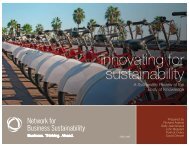embedding sustainability in organizational culture - Network for ...
embedding sustainability in organizational culture - Network for ...
embedding sustainability in organizational culture - Network for ...
You also want an ePaper? Increase the reach of your titles
YUMPU automatically turns print PDFs into web optimized ePapers that Google loves.
Chapter 1: 4: Introduction Clarify<strong>in</strong>g expectations<br />
34<br />
✔ aSSign RESponSiBility to SEnioR lEadERShip: allocate the<br />
responsibility of deliver<strong>in</strong>g on the <strong>susta<strong>in</strong>ability</strong> agenda to senior<br />
leadership roles with<strong>in</strong> the organization, <strong>in</strong>clud<strong>in</strong>g at the board level<br />
• Assign responsibility <strong>for</strong> <strong>susta<strong>in</strong>ability</strong> to board members and/or a<br />
board subcommittee<br />
• Assign responsibility <strong>for</strong> <strong>susta<strong>in</strong>ability</strong> to the CEO<br />
• Assign responsibility <strong>for</strong> <strong>susta<strong>in</strong>ability</strong> to roles with<strong>in</strong> the senior<br />
leadership (create a VP Susta<strong>in</strong>ability, <strong>for</strong> <strong>in</strong>stance)<br />
Actions taken by senior leadership and the board of directors send very strong<br />
signals to the rest of the organization. NBS (2010) suggests establish<strong>in</strong>g a role <strong>for</strong> a<br />
<strong>susta<strong>in</strong>ability</strong> executive who reports directly to the Board of Directors or the CEO.<br />
The creation of a board-level susta<strong>in</strong>able development committee sent a strong<br />
signal <strong>in</strong> one large mult<strong>in</strong>ational company (Wei-Skillern, 2004). Holton et al. (2010)<br />
note that when directors <strong>in</strong> each of their study companies took direct responsibility<br />
<strong>for</strong> <strong>susta<strong>in</strong>ability</strong> that the commitment to <strong>susta<strong>in</strong>ability</strong> was transferred down<br />
through the company. Adriana (2009) found a connection between board member<br />
responsibility <strong>for</strong> environmental supply cha<strong>in</strong> management (ESCM) and the<br />
program’s successful implementation.<br />
The value of assign<strong>in</strong>g responsibility <strong>for</strong> <strong>susta<strong>in</strong>ability</strong> at the senior level <strong>in</strong> the<br />
organization has received empirical support <strong>in</strong> the literature.<br />
assessment: Supported<br />
tra<strong>in</strong><br />
Tra<strong>in</strong><strong>in</strong>g provides employees with the additional skills and knowledge to help them<br />
accomplish tasks, work with systems, or carry out procedures related to or <strong>in</strong>volv<strong>in</strong>g<br />
<strong>susta<strong>in</strong>ability</strong>. Tra<strong>in</strong><strong>in</strong>g clarifies expectations and creates consistency <strong>in</strong> behaviours.<br />
✔ tRa<strong>in</strong>: tra<strong>in</strong><strong>in</strong>g employees <strong>in</strong> systems or procedures related to<br />
<strong>susta<strong>in</strong>ability</strong><br />
• Include <strong>susta<strong>in</strong>ability</strong> tra<strong>in</strong><strong>in</strong>g <strong>in</strong> employee <strong>in</strong>duction programs<br />
(emphasiz<strong>in</strong>g how <strong>susta<strong>in</strong>ability</strong> is at the core of the organization’s<br />
values)<br />
• Invest <strong>in</strong> ethics, environmental and <strong>susta<strong>in</strong>ability</strong> tra<strong>in</strong><strong>in</strong>g <strong>for</strong> all<br />
employees<br />
• Tra<strong>in</strong> managers <strong>in</strong> ethical and susta<strong>in</strong>able decision-mak<strong>in</strong>g,<br />
consistent with the organization’s mission, values and goals<br />
• Customize tra<strong>in</strong><strong>in</strong>g to different audiences us<strong>in</strong>g appropriate<br />
language<br />
• Tra<strong>in</strong> employees to implement and operate <strong>susta<strong>in</strong>ability</strong><br />
management systems<br />
• Provide motivation by describ<strong>in</strong>g learned lessons<br />
• Supplement <strong>for</strong>mal tra<strong>in</strong><strong>in</strong>g with mentor<strong>in</strong>g and coach<strong>in</strong>g<br />
• Provide regular tra<strong>in</strong><strong>in</strong>g updates to keep <strong>susta<strong>in</strong>ability</strong> at the<br />
<strong>for</strong>efront of peoples’ thoughts<br />
Tra<strong>in</strong><strong>in</strong>g has been suggested as an effective way <strong>for</strong> organizations to communicate<br />
the importance of <strong>susta<strong>in</strong>ability</strong> values and strategy to employees. Tra<strong>in</strong><strong>in</strong>g<br />
also ensures that all employees have the right skills sets to support susta<strong>in</strong>able<br />
development. One company sends every new employee on a three-week immersion<br />
program to ensure they understand and enact the company’s values (Ethical<br />
Corporation, 2009). Colbert and Kurucz (2007) suggest that all development<br />
processes can be <strong>in</strong>fused with <strong>susta<strong>in</strong>ability</strong> themes. Susta<strong>in</strong>ability tra<strong>in</strong><strong>in</strong>g can<br />
raise employee awareness of important issues and also improve employee skills<br />
competence. Susta<strong>in</strong>ability tra<strong>in</strong><strong>in</strong>g can cover everyth<strong>in</strong>g from <strong>susta<strong>in</strong>ability</strong><br />
policies, programs, goals, and per<strong>for</strong>mance to all aspects of bus<strong>in</strong>ess operations,<br />
<strong>in</strong>clud<strong>in</strong>g suppliers, waste and emission management, product design and life cycle<br />
(Maon et al., 2009).<br />
Buysse and Verbeke (2003) identified environmental tra<strong>in</strong><strong>in</strong>g as one of five resource<br />
doma<strong>in</strong>s where organizations can engage <strong>in</strong> action to become greener. Holton et al.<br />
(2010) found a trend amongst the companies they studied toward mak<strong>in</strong>g use of<br />
<strong>in</strong>ternal tra<strong>in</strong><strong>in</strong>g <strong>in</strong>stead of third-party tra<strong>in</strong><strong>in</strong>g—the benefits were cost sav<strong>in</strong>gs and<br />
<strong>in</strong>-house knowledge build<strong>in</strong>g and retention. They also saw a trend toward tra<strong>in</strong><strong>in</strong>g<br />
targeted at chang<strong>in</strong>g behaviour, rather than simply develop<strong>in</strong>g technical skills.<br />
Dunphy and colleagues (2003) po<strong>in</strong>t out that when organizations limit tra<strong>in</strong><strong>in</strong>g to<br />
the technical skills required <strong>for</strong> compliance, they are not likely to br<strong>in</strong>g about the<br />
attitud<strong>in</strong>al or cultural change required. Companies found that employees were more<br />
<strong>in</strong>terested <strong>in</strong> <strong>susta<strong>in</strong>ability</strong> if they had opportunities <strong>for</strong> tra<strong>in</strong><strong>in</strong>g and development<br />
(Jenk<strong>in</strong>s, 2006). One organization implemented a n<strong>in</strong>e-month tra<strong>in</strong><strong>in</strong>g program<br />
followed by a company-wide bra<strong>in</strong>storm<strong>in</strong>g session (Smith & Brown, 2003).
















